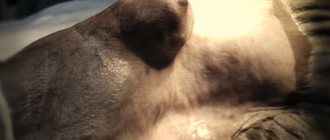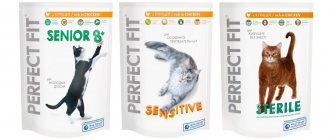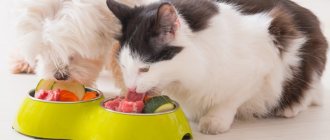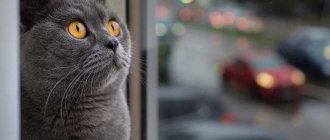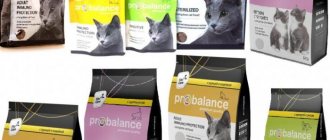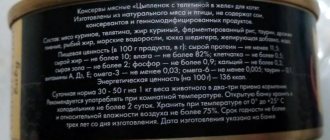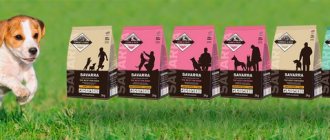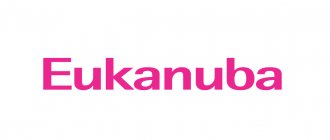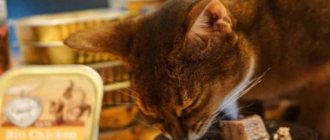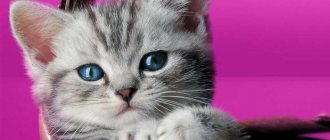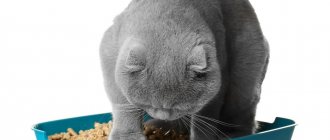Corn has never been a traditional Russian agricultural crop and appeared in large quantities on the fields of the USSR in the 1950s with the light hand of N.S. Khrushchev and was appreciated, perhaps, only in animal husbandry. Let us remind young readers that in those days they did not sell popcorn in cinemas, and in general it was not accepted to eat during the show.
But let’s return to pets and the times when ready-made food for them appeared in Russia. Corn was used in literally every diet sold at that time; there was little information about its nutritional qualities. As a result, perhaps out of ignorance, or perhaps due to someone’s benefit or even dishonesty, false information began to spread among pet owners that this cereal is a source of many beneficial substances for dogs and cats. Moreover, over 20 years this information has become firmly embedded in the consciousness of consumers, and, what is most offensive, continues to thrive in it to this day.
The proof is a message from a reader of our site, who introduced himself as an experienced breeder, in defense of corn, who cites the following quote to prove his position: “Corn has high nutritional properties. It is a good source of Omega-6 fatty acids, which promote the development of healthy skin and a shiny coat, minerals, vitamins including folic acid, vitamin C, niacin and starch. It is noteworthy that here, for cats and dogs, starch is an important source of energy."
The original source of this quote is unknown, but it is widely circulated on the Internet, and we would like to detail the information contained in it, point by point.
Corn in feed - the whole truth about “high nutritional properties”
The highly nutritional properties of corn are determined by the high content of carbohydrates - more than half of them (60 g per 100 g). This is great news for people who want to get better, but not for cats and dogs. People, indeed, get energy primarily from carbohydrates and fats, and to a much lesser extent from proteins. You’ve probably heard about the famous “Kremlin diet”, which consists exclusively of animal proteins and, according to reviews, gives amazing results - note, for the figure, but not for health. It’s in these numbers that her secret lies.
Dogs and cats are structured completely differently: they get most of their energy from fat, and much less from proteins and carbohydrates. Since corn primarily consists of carbohydrates, it, like all other grains, cannot be called highly nutritious for carnivores. Therefore, corn in feed, especially in large quantities, is not only not nutritious, but also extremely unphysiological, and also absolutely useless.
However, perhaps the idea of the high nutritional value of corn in the above quote is associated not with carbohydrates, but with vegetable protein, which is also contained in this cereal (10.3 g per 100 g). However, this idea does not stand up to criticism, since plant protein is very poorly absorbed by carnivores.
Here are the data on the digestibility of protein from various foods in dogs, calculated using the generally accepted hundred-point system. The highest score - 100 - is assigned to the product that has the highest digestibility.
| Protein | Digestibility |
| Egg white | 100 |
| Muscle meat (chicken, beef, lamb) | 92 |
| Internal organs (liver, kidneys, heart) | 90 |
| Milk, cheese | 89 |
| Fish | 75 |
| Soybeans | 75 |
| Rice | 72 |
| Oats | 66 |
| Yeast | 63 |
| Wheat | 60 |
| Corn | 54 |
These indicators show that the protein in corn, and this applies to almost all plant proteins, is digested almost twice as poorly as muscle meat. This means that corn in food for cats and dogs not only does not increase, but complicates the digestibility of the diet.
Composition and properties of the product
Botanical scientists have found that corn first appeared on the territory of modern Mexico more than 7 thousand years ago. That is why it is considered one of the oldest grain plants on the planet.
This culture contains many useful substances:
- vitamins B, C, A, E;
- iron;
- magnesium;
- calcium;
- zinc;
- potassium;
- cellulose;
- fluorine;
- copper;
- iodine;
- phosphorus;
- fats (4.5% by weight);
- proteins (9.5% by weight);
- carbohydrates (4.7% by weight).
Corn has not only a pleasant taste and smell, but also a number of useful properties:
- Activates metabolic processes in the body.
- Easy to digest.
- Improves mood and well-being.
- Supports vitality.
- Contains a large amount of calories - 365 kcal per 100 grams.
Corn in Dog Food: Is Starch Healthy?
Surprisingly, corn starch, listed among the vitamins and minerals in the above quote, is actually one of the most harmful components of corn. It is responsible for increasing the risk of diabetes, as well as increasing obesity in dogs and cats. The main reason is the high glycemic index. This indicator gives an idea of how sharply the blood glucose level increases after consuming the product. Foods with a high glycemic index cause a sharp jump in glucose levels, and accordingly, the production of the hormone insulin. The wider the amplitude and speed of this “glycemic swing”, the higher the risk of obesity and diabetes. By the way, this also applies to people. Look at the table and you will see that our corn starch is a real record holder in terms of glycemic index.
| Product | Glycemic index |
| Corn starch | 85 |
| Rice starch | 85 |
| Wheat flour | 85 |
| Potato | 45 |
| Buckwheat | 40 |
| Oats | 40 |
| Beans | 40 |
| Chickpeas | 30 |
| Beans | 30 |
| Peas | 35 |
| Lentils | 27 |
From this table we see that not only corn, but also rice and wheat have a high glycemic index, but legumes, on the contrary, have a low one. That is why many manufacturers refuse to use these grains in their feeds, and since it is impossible to do without carbohydrates in the production of extruded feeds, they replace them with other components with a lower glycemic index.
But this does not mean that legumes are an excellent component in food; they are also not physiological for carnivores, but they are simply the lesser of two evils. But the most important question is the quantity: if corn in cat and dog food was used only as a binding component (and for this you need very little), there would be fewer objections. But when it takes up almost half of the composition and at the same time we are convinced that this is an excellent and COMPLETE ingredient for predators, then this causes nothing but indignation.
About vegetables in the cat's menu
They are an addition to the diet for cats. Veterinarians state that the optimal content is 5-15% vegetables in pet menus. They serve as a source of carbohydrates and vital energy for cats.
Let us remember that by their nature these animals are predators. Therefore, their body is initially configured to accept food of animal origin and digest proteins, not carbohydrates. The main diet of animals consists of meat and fish, dairy products, if we talk about the natural method of feeding. Even porridge as a carbohydrate food should not be given to cats often.
Veterinarians advise offering cats raw vegetables and focusing on their taste preferences. For example, carrots will be useful for pets as a means of cleaning their teeth. After all, when feeding natural food, soft plaque accumulates on the chewing organs, which over time turns into tartar. The task of fresh vegetables is to clean it and prevent the development of caries and periodontal disease.
Many cats love cabbage, especially broccoli. Cheers! This is one of the healthiest vegetables on a cat's menu.
Beets, greens, bell peppers, cucumbers, zucchini, and spinach can also be present in the diet of pets. But it is advisable not to give them potatoes. This is the starchiest vegetable and puts a lot of stress on a cat's pancreas. Therefore, it is better not to offer it boiled. Sometimes animals like to chew raw potatoes cut into pieces - this is how they clean their teeth.
Veterinarians advise cat owners to combine vegetables in their diet with meat and offal. This is the best and healthiest option for feeding animals. If the owner boils vegetables, then a little vegetable oil should be added to them.
When feeding an adult cat natural food, do not forget that the daily portion of food should not exceed 5% of the animal’s weight. For example, if a cat weighs 4 kilograms per day, he should eat 200 grams of food. For older and sedentary cats, this figure may be even lower. But for the active and mobile - a little more.
Why is fish bad for cats?
Fish is not suitable for feeding cats due to the fact that fish protein, being quickly absorbed, leads to an increased load on the cat’s kidneys, destroying the balance of minerals, and urolithiasis can develop. You should not think that only neutered cats are susceptible to kidney and bladder diseases.
The frequent presence of fish in a cat's diet can lead to vitamin K deficiency, which in turn can cause decreased blood clotting and death.
Raw fish can cause oxidative stress in the animal, that is, a redox imbalance appears. Fish can cause cat passivity, as well as the appearance of worms.
If you still want to pamper your cat with fish, then choose sea fish and give it no more than once every two weeks.
Why is liver bad for cats?
Frequent consumption of liver can provoke disruption of metabolic processes in the cat’s body, since the liver contains too many biologically active substances.
Liver can also cause stomach upset in cats if this product is given raw. But boiled liver is also dangerous because it can cause constipation in a cat.
Why are bread, corn, beans and peas bad for cats?
The above products contain large amounts of carbohydrates, which, if consumed frequently or in large quantities, can cause intestinal colic and develop flatulence.
Why are cheap cat foods harmful to cats?
There is a wide variety of cat food in colorful packaging on store shelves. Without packaging, all these foods also look attractive in the form of various figures, stars and bones. The composition of these foods leaves much to be desired, but cats can eat them without interruption. It's all about the additives that make this inedible product so attractive to cats.
But it should be remembered that such cheap food can develop multiple diseases in cats, including gastritis, urolithiasis, and dermatitis. If you decide to buy cat food, it is better to do it in specialized stores. Don't be seduced by the cheapness and beautiful packaging.
Why you shouldn't feed your cat from your table
The food from our table is completely unsuitable for cats, as it contains various spices and salt that are harmful to cats, which can also provoke the development of various diseases. Remember that a cat that eats a healthy diet, one that is suitable for cats, can live as long as twenty years. And by feeding a cat from the table, you shorten its life. You should not succumb to such a pleading pitying look from your pet, since even a small piece of sausage can cause the smallest thing in a cat - intestinal colic.
Olga Glukhareva based on open source materials
Hello, dear readers of the “Children of Fauna” blog, on streams I am often asked: “Can a dog have melon and watermelon?” I decided to answer this question in a separate article and expand the answer a little, also mentioning apples, pears, apricots, tomatoes, cucumbers, and other vegetables and fruits. We are talking about dogs, but the principles are the same when feeding cats. Let's start with watermelon and cantaloupe, yes, you can give your dog these foods as treats. Let me remind you that treats should not be the basis of the diet; we give them little and rarely. And take into account the proportions, especially if you have a small breed dog, a small piece for a person will be huge for a Yorkie, Chihuahua, Toy, Spitz...
In addition, there may be individual sensitivity. If you gave melon, watermelon, peach, cucumber... (any fruit, vegetable or berry), and the dog developed vomiting, diarrhea, itching, redness on the skin, and other symptoms, then such products are not suitable for your dog.
Corn and Omega-6 fatty acids
Let's move on. Omega-6 fatty acids are indeed very beneficial and necessary in the diet of both people and their pets. But it must happen that in the assimilation of this polyunsaturated fatty acid, cats and dogs do not want to resemble the “crown of creation”. Omega-6 polyunsaturated fatty acid comes in active and inactive forms. The body of omnivorous animals (rats, pigs, most types of bears), as well as the human body, can partially convert the inactive form into an active one and use it for its needs.
In carnivorous animals, such as cats and dogs, such a mechanism was not formed during the process of evolution - it is not needed by animals that eat only meat. Corn contains Omega-6 in an inactive form, which means that no matter how much you feed it to dogs and cats, there will be no benefit, because it simply cannot be absorbed by their body.
Benefits and harms
Veterinarians allow corn to be given to cats, as it is rich in vitamins and minerals. Cereal grains are not completely digested by the animal’s body, and therefore are a natural brush for the gastrointestinal tract. However, before introducing corn into a kitten’s diet, it is recommended to weigh the pros and cons of the product presented in the table:
| Positive Impact | Possible danger |
| Normalization of metabolic processes | Risk of obesity due to overeating |
| Improved mood | Increased gas formation |
| Intestinal obstruction due to overfeeding | |
| Replenishing energy reserves | Diarrhea |
| Returning shine to fur | Difficulty defecating |
| Improved intestinal motility | Stomach pain |
| Strengthening teeth | Allergic reaction to corn starch |
Return to contents
Niacin in corn
And with niacin (nicotinic acid), contained in corn, it’s a completely different story. Until now, in South America and Africa, in countries that are not very prosperous in terms of the well-being of the population, such a rare disease as pellagra occurs, associated with insufficient intake of nicotinic acid into the body (another name for the substance is vitamin PP).
We will not describe the eerie symptoms of this disease, let’s just say that pellagra causes serious skin problems and dementia (dementia). In the 19th century, pellagra was epidemic in nature, and the doctors of that time were sincerely perplexed: why vitamin deficiency PP is raging in countries where the population eats mainly corn, so rich in niacin! Only later did it become clear that corn contains niacin in a bound, practically indigestible form, and even for humans, “golden grains” cannot serve as a source of this substance.
If niacin from corn is not absorbed by omnivores, then there is nothing to say about carnivorous animals. The situation is especially critical with cats. For example, in dogs, niacin can be partially synthesized from the essential amino acid tryptophan, but the meowing brethren should receive it only with food, and in a “ready” form, that is, a highly digestible form in which it is found in meat rich in this substance.
Is corn safe for cats?
The good news for cat owners is that your pet can occasionally indulge in corn without any unpleasant consequences. If you catch him eating corn kernels, there is no need to worry (unless they are sprinkled with herbs and spices that can be harmful to health).
The basic rule of feeding an animal with human food is to give it rarely and in small portions.
Is corn rich in vitamin C?
Well, finally, we got to vitamin C - and let’s say right away that there is very little vitamin C in corn; fresh vegetables, fruits and berries hold the record for its content. We emphasize that they are fresh, because when heated, vitamin C is quickly destroyed. But this is not scary, because nature did not prepare cats and dogs to absorb vegetables and fruits, and therefore created a mechanism thanks to which vitamin C is perfectly synthesized in their body without any supply from the outside.
Back in 1931, this was confirmed by a convincing experiment. The puppies were kept on a diet completely devoid of vitamin C for 150 days. Guinea pigs, which are known to be unable to synthesize vitamin C, were used as a control group. As a result, after the test, no growth retardation or developmental disorders of the skeletal and dental systems were recorded in the puppies. Moreover, a sufficient amount of vitamin C was found in their liver - evidence that all this time their body was doing an excellent job of synthesizing this important substance. But the guinea pigs were less fortunate: 25 animals died during the experiment from scurvy, the rest were in the last stage of the disease. No such experiment was carried out on cats, but studies have documented exactly the same mechanism of synthesis in them, and observations of specialists have shown that they also do well without vitamin C, eating dry diets not additionally enriched with this substance.
What corn products should not be given?
Despite all the beneficial properties of this cereal, veterinarians equate it to fast food and recommend giving it to cats only occasionally. There is also a number of products from this culture, which, due to their high fat and sugar content, are strictly forbidden to be fed to kittens and adults.
These include:
- Chips – contain too much fat.
- Corn sticks - they contain a lot of sugar.
- Corn salted snacks. They are usually used as snacks for alcoholic drinks and contain not only a lot of salt, but also all kinds of spices.
- Popcorn. Cats love playing with popcorn because it makes such a tempting noise. However, during such games the pet may choke on this product. In addition, caramel, salt or butter are added to popcorn, which also poses a risk to your pet’s health.
Cats should not be given popcorn!
Folic acid in corn - yes or no
As for folic acid, the situation is different. Carnivores must receive folic acid from food, and a deficiency of this substance during pregnancy is especially critical, as it leads to severe pathologies of the fetus. In a more or less digestible form for carnivores, folic acid is found only in fresh greens, as well as in organ meats, and this digestibility varies greatly. In plants, its bioavailability is 30%, in meat - 80% (Gregory, 1991a; Clifford etal, 1990). But this does not save dry food manufacturers, because folic acid is quickly destroyed when heated. That is why it is added to diets additionally, but, of course, not in the form of corn, which is completely useless in this sense, but in the form of special additives, which pharmacists have worked hard on, creating drugs with the highest bioavailability.
Can cats eat chocolate?
The main “sweet enemy” for cats is chocolate.
, which contains substances that are toxic to cats! Theobromine, present even in white chocolate, can be fatal if consumed by a cat.
Interesting materials:
What is a dry cough and a wet cough? What is the Coupon Amount? What is a touch screen? What is a technically complex device? What are current payments in bankruptcy? What is current repair of MKD? What is a TV with a built-in satellite tuner? What is the type of sale 214 FZ? What is Tko Mosenergosbyt? What is TCO waste?
Debunking the Queen of the Fields
If you still don’t want to part with the myth about the benefits of corn, then we will admit to you honestly: it really does have enormous benefits - worth millions of dollars! How? Yes, very simple!
Corn is one of the cheapest products in feed; it allows you to save significantly on more expensive ingredients. Corn is extremely convenient for the technological process of producing dry food, since, thanks to its starch content, it perfectly binds the components of the feed and the manufacturer does not need to spend money on unnecessary ingredients and equipment.
Corn is economical because it contains some vegetable protein. If you put a lot of corn in the feed, then even “dropping” it into it for the sake of appearance of meat, it is quite possible to obtain the percentage of protein in the composition required by the industry.
We still hope that we have been convincing enough in debunking the myths about the “queen of the fields” as an excellent ingredient in dog and cat food, although, of course, much more could be said about this. If you wish, you can look for information on this matter yourself - just rely on scientifically based information, and not on irresponsible statements by illiterate marketers.
Health risks
Allergies are a common problem. The signs are:
When checking whether cats can eat corn, the owner gives a small portion and waits for symptoms to appear. When they occur, grains and products containing them are excluded from the diet. Severe allergies require an immediate visit to the veterinarian.
Giving your cat a lot of corn is not a good idea because of the risk of digestive upset. As a source of carbohydrates, it promotes weight gain. The off-season product contains a large amount of nitrates. Even when harvested at the right time, grain may contain pesticides and other harmful chemicals that do not completely decompose during heat treatment.
Conditionally acceptable products
The answer to the question whether cats can have boiled corn is “yes.” This is one of the safest forms of feeding cereal to your pet. An alternative option is grilled cob.
